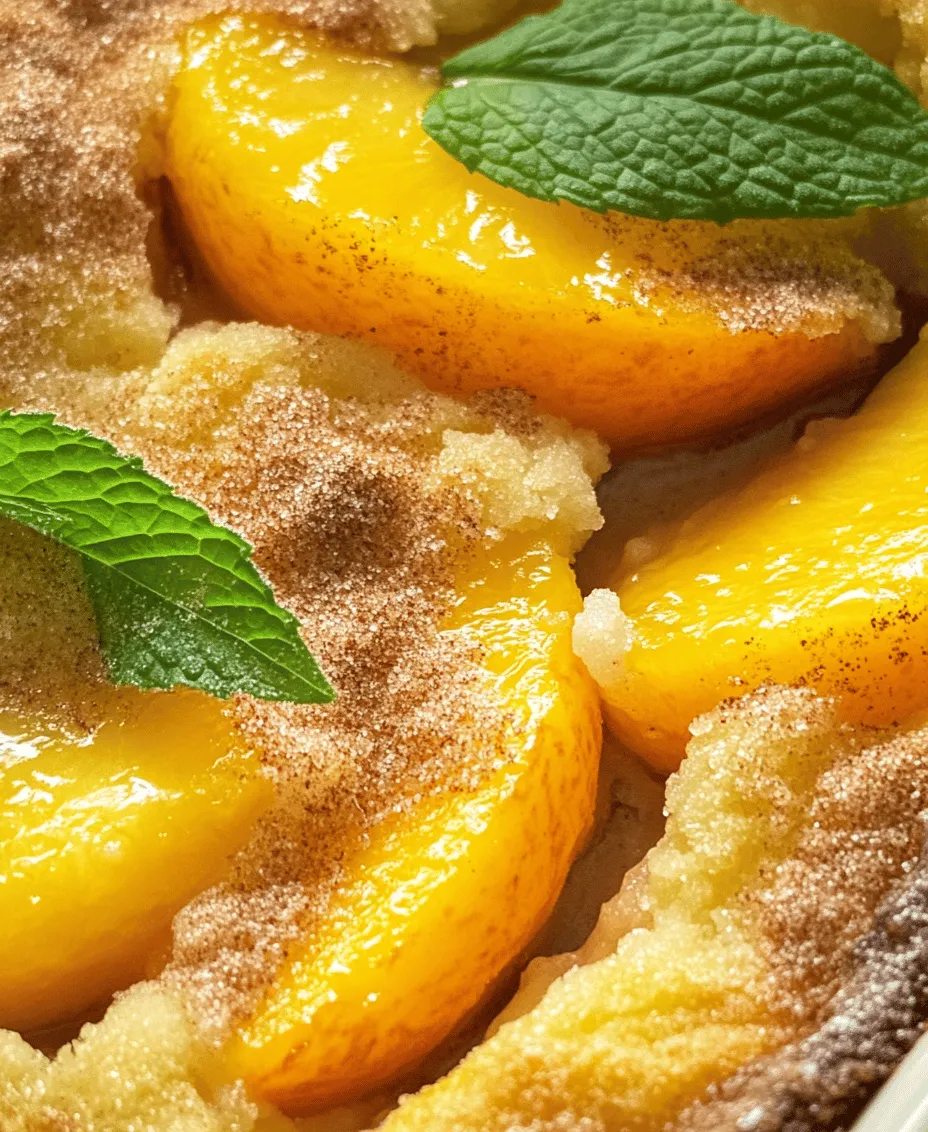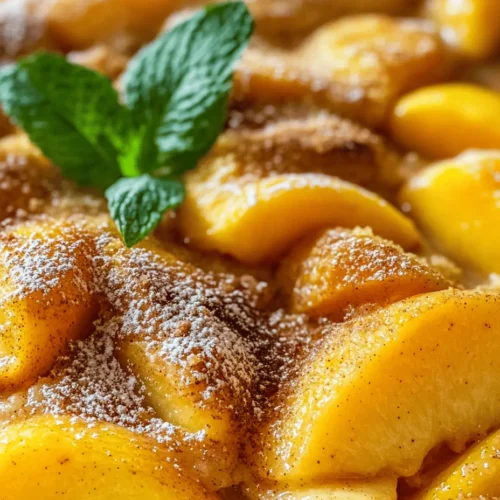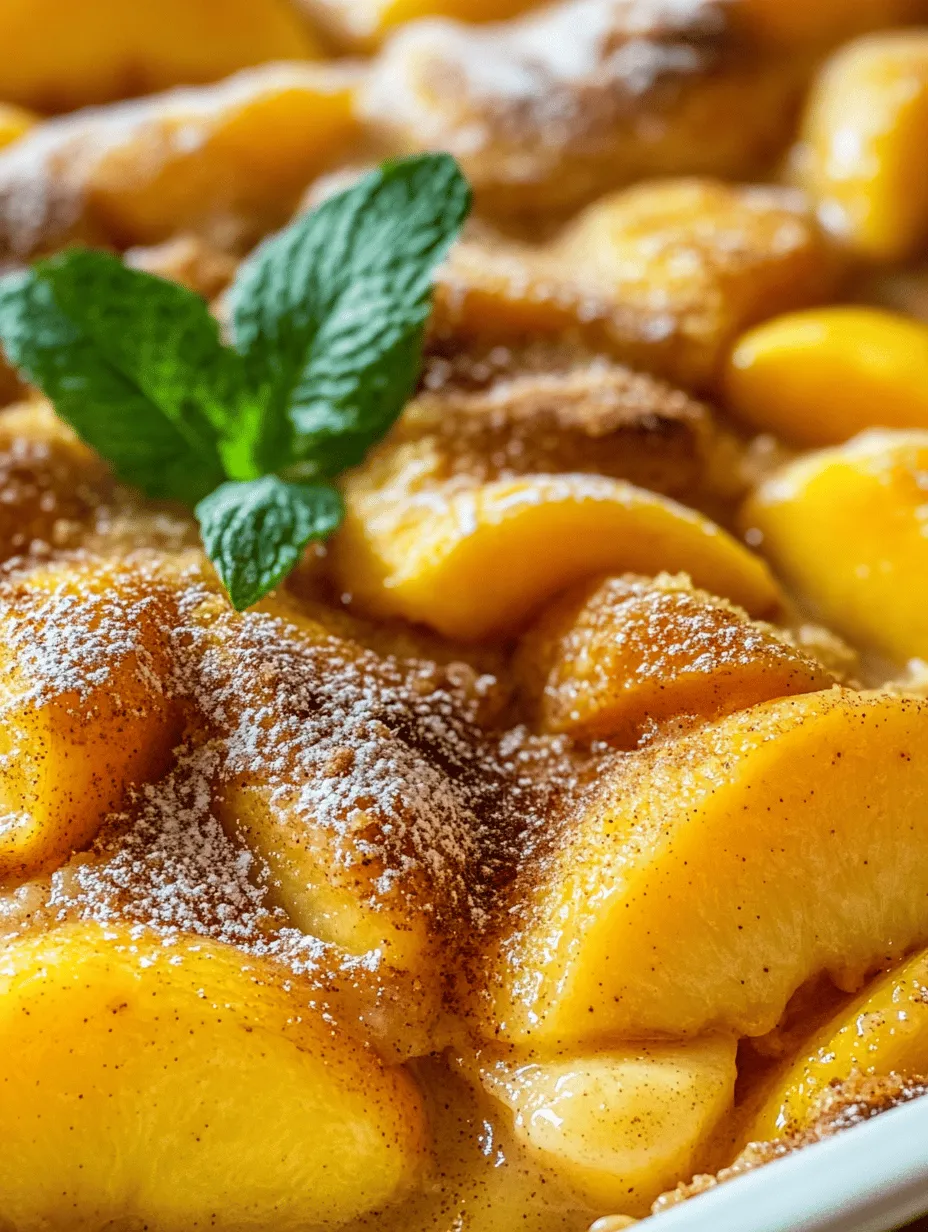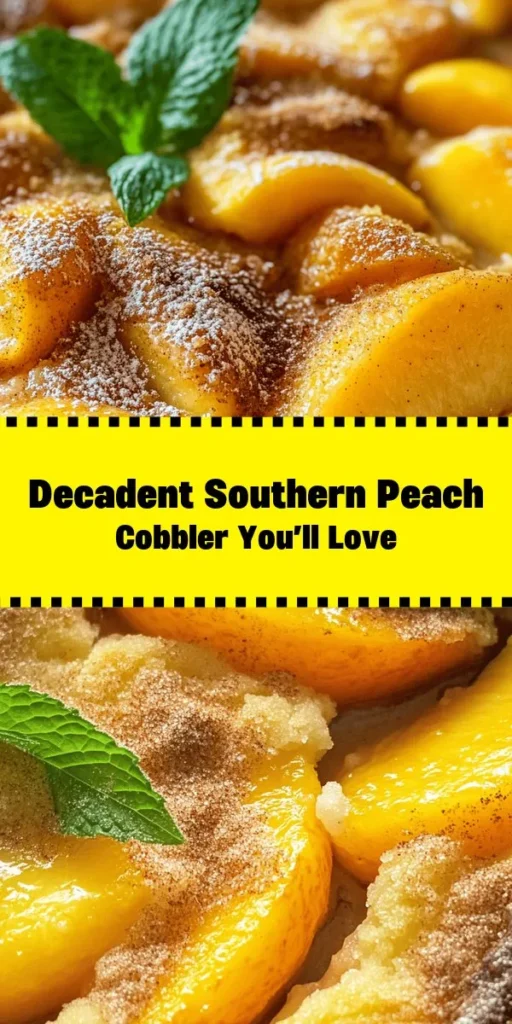Introduction
Peach cobbler is a quintessential Southern dessert that has delighted generations with its warm, comforting flavors and delightful aroma. This dish embodies the essence of Southern cooking, showcasing the region’s rich agricultural produce, particularly its juicy, sun-kissed peaches. The beauty of peach cobbler lies in its simplicity; it brings together fresh, ripe peaches and a buttery, golden crust, creating a sweet symphony that is both nostalgic and satisfying.
Using fresh, ripe peaches is paramount to achieving the perfect peach cobbler. Their natural sweetness, paired with a hint of tartness, elevates the dish, making it a standout dessert that resonates with anyone who has ever savored a slice. The appeal of homemade desserts like peach cobbler goes beyond taste—they evoke memories of family gatherings, summer picnics, and community celebrations, where the comforting aroma of baked goods fills the air.
The Allure of Peach Cobbler
The history of peach cobbler is steeped in Southern tradition, reflecting the region’s agricultural roots and culinary creativity. This dessert emerged in the United States during the early 19th century and quickly became a staple in Southern households. Originally, cobblers were made using a variety of fruits, but the sweet, juicy peach became the star of the show in many Southern kitchens due to its abundance during the summer months.
Culturally, peach cobbler holds a cherished place in Southern gatherings. It is often the centerpiece at potlucks, family reunions, and holiday feasts, symbolizing hospitality and warmth. The act of baking a peach cobbler is not just about creating a delectable dish; it is a way of connecting with family traditions and fostering togetherness. Each family may have its own secret recipe, passed down through generations, adding a personal touch to this beloved dessert.
Variations of peach cobbler can be found across different regions, showcasing local ingredients and culinary influences. Some may prefer a biscuit topping, while others enjoy a cake-like batter or a crumbly streusel finish. Despite these variations, the core of peach cobbler remains the same—a celebration of ripe peaches enveloped in a comforting, sweet crust.
Ingredients Breakdown
Fresh Peaches
The star of any peach cobbler is, of course, the peaches. Choosing the right peaches is crucial for achieving the best flavor and texture. Look for peaches that are firm yet slightly soft to the touch, with a fragrant aroma that indicates ripeness. The color should be a vibrant yellow or golden hue, with a hint of red blush. Avoid peaches with blemishes or overly soft spots, as these may indicate overripeness or spoilage.
For the ultimate peach cobbler experience, nothing beats the flavor of fresh, in-season peaches. However, if fresh peaches are not available, frozen peaches can be a suitable alternative. If you opt for frozen, make sure to thaw them and drain any excess liquid to maintain the intended consistency of the cobbler.
Sugar
Sugar plays a vital role in peach cobbler, balancing the sweetness of the fruit while enhancing its natural flavors. The type and amount of sugar can vary based on personal preference and the ripeness of the peaches. Granulated sugar is the most common choice, but brown sugar adds a deeper, caramel-like flavor that can complement the peaches beautifully.
When preparing your cobbler, be mindful of the sugar’s contribution to the overall flavor. A good rule of thumb is to start with a moderate amount and adjust according to the sweetness of your peaches and your taste preference.
Lemon Juice
Adding lemon juice to your peach mixture may seem like an extra step, but it is essential for brightening the dish. The acidity of lemon juice enhances the natural flavors of the peaches and balances the sweetness, creating a well-rounded flavor profile. A tablespoon or two is typically sufficient to elevate the taste without overpowering the delicate fruit.
Spices
Spices like cinnamon and nutmeg add warmth and depth to the peach cobbler, taking it from a simple dessert to a complex flavor experience. Cinnamon, with its sweet and aromatic profile, pairs beautifully with peaches, while nutmeg adds a hint of earthiness. When using spices, it’s crucial to strike a balance; a little goes a long way, so start with a small amount and adjust according to your taste.
Optional Ingredients
For those looking to enhance the texture and flavor of their peach cobbler, consider incorporating cornstarch and almond extract. Cornstarch acts as a thickening agent, helping to create a luscious filling that isn’t overly runny. A tablespoon or two can achieve the desired consistency without compromising the flavor.
Almond extract, while optional, can infuse a subtle nuttiness into the cobbler that complements the sweetness of the peaches. Use it sparingly, as its flavor is potent and can easily overpower the dish.
Preparation Steps
Now that we have a solid understanding of the essential ingredients, let’s dive into the preparation steps for making your classic Southern peach cobbler.
Step 1: Preparing the Peaches
Begin by gathering your fresh peaches. You’ll need about 6-8 medium-sized peaches, depending on their size and how full you want your cobbler to be. Start by washing the peaches thoroughly under running water to remove any dirt or residues.
Next, it’s time to peel the peaches. A simple method for peeling peaches is to blanch them. Bring a pot of water to a boil, then prepare an ice bath in a large bowl. Place the peaches in the boiling water for about 30 seconds, then immediately transfer them to the ice bath. The skins will loosen and can be easily slipped off.
Once peeled, slice the peaches in half and remove the pits. For a more manageable cobbler, cut the peach halves into thick slices or chunks, depending on your preference. Aim for uniform pieces to ensure even cooking.
Step 2: Marinating the Peaches
After preparing the peaches, it’s essential to let them marinate. This step allows the fruit to release its juices and meld with the sugar and lemon juice, intensifying the flavors. In a large mixing bowl, combine the sliced peaches with sugar, lemon juice, and any spices you wish to add. Gently toss to coat the peaches evenly.
Let the mixture sit for about 30 minutes. During this time, the peaches will soften and the juices will accumulate, creating a flavorful syrup that will enhance the filling of your cobbler.
Step 3: Crafting the Cobbler Batter
While the peaches are marinating, it’s the perfect time to prepare the cobbler batter. The batter can vary depending on your preferred texture, but a classic cobbler typically features a simple biscuit-like topping.
In another mixing bowl, combine flour, sugar, baking powder, and salt. Whisk the dry ingredients together until well-blended. Next, cut in cold butter using a pastry cutter or your fingers until the mixture resembles coarse crumbs. This step is crucial for achieving a flaky texture in your cobbler crust.
Once the butter is incorporated, make a well in the center and add milk or buttermilk. Stir until just combined, being careful not to overmix; a few lumps are perfectly fine.
The final step in assembling your cobbler is crucial: spoon the batter over the marinated peaches, ensuring even coverage. You can either dollop the batter in spoonfuls or spread it out gently with a spatula, depending on the look you desire.
Now that you have prepared the peaches and crafted your cobbler batter, you are well on your way to creating a classic Southern peach cobbler that is sure to impress! Stay tuned as we delve into the baking process and provide tips to ensure your cobbler turns out perfectly golden and delicious.

Mixing Dry and Wet Ingredients: Key Techniques to Ensure a Fluffy Texture
Creating the perfect classic Southern peach cobbler relies heavily on the mixing of dry and wet ingredients. To achieve that light, fluffy texture that characterizes an outstanding cobbler, follow these essential techniques. Begin by sifting together your dry ingredients—flour, baking powder, sugar, and a pinch of salt. Sifting not only helps remove any lumps but also aerates the flour, allowing for a lighter batter.
Once your dry ingredients are well-combined, it’s time to focus on the wet ingredients. This typically includes milk, melted butter, and vanilla extract. When combining the wet ingredients, ensure that your melted butter has cooled slightly before adding it to prevent cooking the eggs if they are included.
The key here is to mix the wet ingredients until just combined—no need for perfection. Over-mixing will develop the gluten in the flour, leading to a dense and chewy texture rather than the desired fluffy and cake-like result. A few lumps in the batter are perfectly acceptable.
The Significance of Not Over-Mixing the Batter
Over-mixing can be a common pitfall, especially for beginner bakers. The gluten in the flour, when activated through excessive mixing, creates a tougher texture that is not ideal for a cobbler. Instead of a light and airy dessert, you’ll end up with something that resembles a dense bread. Always keep in mind that less is more when it comes to mixing. Aim for a cohesive batter with some lumps for the best results.
Layering the Cobbler
Now that your batter is ready, the next crucial step is layering the peach filling and batter for optimal results. Proper layering helps create a cobbler that is beautifully balanced between the sweet peaches and the fluffy topping.
Start by pouring the peach filling into your prepared baking dish. Ensure the peaches are evenly distributed across the bottom. Then, gently dollop the batter over the peach mixture. Use a spatula to spread it out slightly, but don’t worry about making it perfect. As the cobbler bakes, the batter will rise and create a beautiful crust that envelops the peaches.
How to Properly Layer the Peach Filling and Batter for Optimal Results
For the best layering technique, consider the following tips:
1. Peach Layer: Make sure your peach filling is warm but not boiling. This helps the batter to bake evenly and soak up some of the peach juices as it cooks.
2. Batter Distribution: When dolloping the batter, try to leave some gaps to ensure steam can escape during baking, which will help the topping to rise and become fluffy.
3. Visual Cues: You should see some peach filling peeking through the batter. This creates a lovely contrast in the final presentation and ensures that each slice has a good balance of peach and topping.
Baking the Peach Cobbler
Now comes the moment of truth—baking your peach cobbler to perfection. Preheat your oven to 350°F (175°C), which is the optimal temperature for even baking.
Optimal Baking Temperature and Time
Once your cobbler is assembled, place it in the oven and bake for approximately 45-50 minutes. The exact time may vary depending on your oven and the depth of the dish used.
Visual Indicators of Readiness: Color, Texture, and Toothpick Test
Your cobbler is ready when the top is golden brown, and the batter has risen beautifully above the peach filling. A toothpick inserted into the center should come out clean or with a few moist crumbs (not wet batter). The edges should be bubbly, and the center should feel firm to the touch.
Cooling Period: Why It’s Essential Before Serving
After baking, allow the cobbler to cool for at least 15-20 minutes. This cooling period helps the filling to set and makes it easier to serve. If you cut into it immediately, the warm juices might run out, making for a messier presentation. Allowing it to rest will enhance the flavors and give you a more enjoyable serving experience.
Serving Suggestions
Now that your classic Southern peach cobbler is baked and cooled, it’s time to think about how to serve it up beautifully.
Traditional Accompaniments: Vanilla Ice Cream and Fresh Mint
Nothing pairs quite like a scoop of creamy vanilla ice cream with warm peach cobbler. The contrast of temperatures creates a delightful experience that is truly irresistible. For an added touch, garnish with a sprig of fresh mint, which not only enhances the visual appeal but also adds a refreshing flavor.
Creative Serving Ideas: Pairing with Whipped Cream, Yogurt, or a Drizzle of Caramel
For those looking to switch things up, consider serving your peach cobbler with a dollop of whipped cream, a scoop of yogurt, or even a warm drizzle of caramel sauce. Each option brings a unique twist to the traditional dish.
Presentation Tips for an Inviting Dessert Display
To make your dessert display as inviting as the cobbler itself, consider serving it in a rustic dish that highlights the homemade charm. A cast-iron skillet or a vintage pie dish can enhance the visual appeal. Use decorative serving dishes and garnish with fresh fruit or mint leaves for a pop of color.
Nutritional Insights
While peach cobbler is undeniably a treat, it’s also important to consider its nutritional profile.
Breakdown of Calorie Count and Nutritional Benefits of the Ingredients
A typical serving of peach cobbler can contain around 300-400 calories, depending on the portion size and the specific ingredients used. Peaches are a great source of vitamins A and C, fiber, and antioxidants. They contribute not only to the flavor but also to the overall nutritional value of the dessert.
Discussion on Portion Control and Health-Conscious Alternatives
If you’re mindful of calorie intake, consider controlling portion sizes or even using less sugar in the filling. You can also opt for whole wheat flour in the batter for added fiber. Using a sugar substitute can lighten up the dish while still maintaining its sweetness.
The Role of Seasonal Fruits in a Balanced Diet
Incorporating seasonal fruits like peaches into your diet is a delicious way to enhance your overall nutrition. They are low in calories and high in vitamins, making them a smart choice for desserts and snacks alike. Embracing seasonal produce not only supports your health but also encourages creativity in the kitchen.
Conclusion
Making a classic Southern peach cobbler is not just about following a recipe; it’s about creating a warm, comforting dessert that evokes feelings of nostalgia and joy. Sharing this cobbler with family and friends is a wonderful way to bring everyone together, creating lasting memories around the table.
Don’t hesitate to experiment with variations—try adding a hint of cinnamon to the peaches, or swap out some of the peaches for blueberries or blackberries. The beauty of this dish lies in its versatility and your ability to put a personal touch on it.
Ultimately, the joy of homemade desserts goes beyond just the taste; it’s about the love and effort put into each bite. So roll up your sleeves, embrace the process, and enjoy every delicious moment spent in your kitchen.



